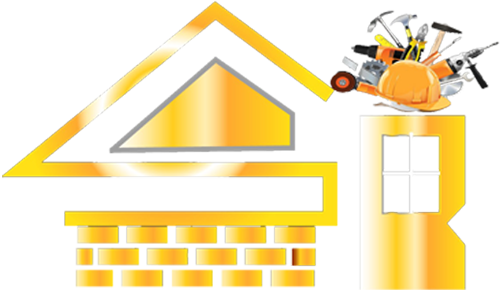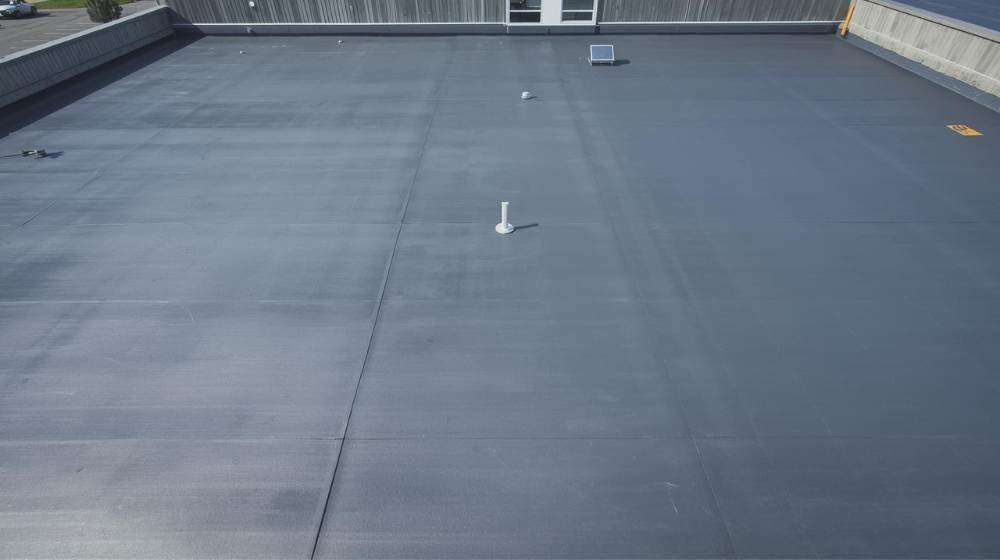
Are you looking for a roof that can last for decades with minimal maintenance? Rubber roofing might be the solution you’re looking for. Rubber roofs are known for their durability and low maintenance; they’re a great choice for both residential and commercial buildings.
In this blog, we’ll dive into the pros and cons of rubber roofing, explain why it’s a popular option, and help you decide if it’s the right choice for your roof. We’ll also compare it with other materials, explore the different types of rubber roofing, and share tips for choosing the best option. Let’s get started!
What Is a Rubber Roof?
A rubber roof, often made from EPDM (a type of synthetic rubber), is a roofing material designed for flat or low-slope roofs. It’s made from synthetic rubber, which makes it highly flexible and durable. Rubber roofs are simple to install and have a long lifespan, lasting up to 50 years with proper care. They’re also waterproof, which makes them an excellent choice for protecting your building from leaks. Rubber roof (EPDM) is also resistant to UV rays, ozone, and extreme temperatures, making it perfect for different climates.
Pros and Cons of Rubber Roofing
In this section, we’ll dive into the pros and cons of rubber roofing. You’ll learn the main benefits of rubber roofing, as well as what to consider before choosing it. Let’s unleash the key information to help you decide if it’s the right fit for your roof.
Advantages of Rubber Roofing
Durability and longevity
Rubber roofing is known for its long lifespan, especially in places like Brooklyn, where temperatures can change frequently. Rubber roofs can last anywhere from 30 to 50 years with minimal care. They can handle extreme heat in the summer and freezing temperatures in the winter. Brooklyn’s unpredictable weather won’t affect the performance of your rubber roof, as it can expand and contract without cracking.
Weather Resistance
Rubber roofs are built to handle harsh weather conditions. In Brooklyn, where you can face both snow and heavy rain, rubber roofing holds up well. The material is waterproof and can resist high winds and hail without damage. Rubber roofing lasts in winter’s cold and summer’s heat.
Energy Efficiency
Did you know that rubber roofing can save you up to 30% on energy costs? Lighter-colored rubber roofs reflect sunlight, which helps to keep your building cool. This can be a big help during Brooklyn’s hot summer months, which reduces your reliance on air conditioning. The energy savings are not just in cooling but also in maintaining consistent temperatures inside the building.
Low Maintenance
One of the best things about rubber roofing is its low maintenance needs. You don’t have to spend a lot of time or money on upkeep. Here are some quick tips for keeping your rubber roof in top shape:
- Inspect the roof for any damage, especially after storms.
- Clear debris from the roof to prevent blockages.
- Check the seams periodically to ensure they’re sealed properly.
- Clean the surface to maintain the reflective properties.
- Repair any small punctures immediately to avoid leaks.
Waterproofing Properties
Rubber roofing is completely waterproof, which is crucial for flat or low-slope roofs. The material’s seamless nature means there’s no chance for water to seep through. This is especially important in Brooklyn, where heavy rains are common. With rubber roofing, you don’t have to worry about leaks or water damage.
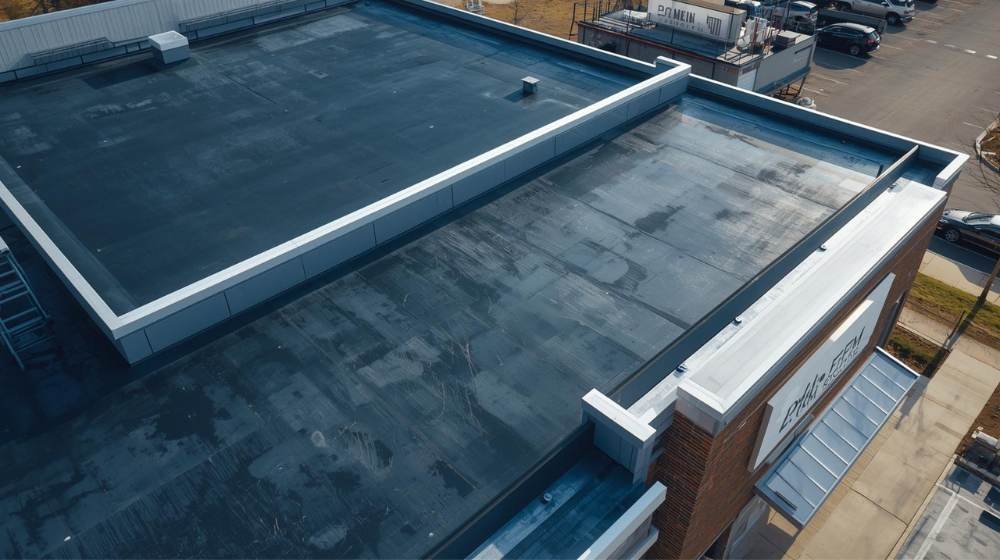
Eco-Friendly Material
Rubber roofing is an eco-friendly option that is made from recycled materials, which helps reduce waste. When the roof reaches the end of its lifespan, it can be recycled again. This makes it a great choice for anyone looking to make a more sustainable decision for their building. Not only is it beneficial for the environment, but it also reduces your carbon footprint in the long run.
Disadvantages of Rubber Roofing
Vulnerability to Punctures
Sharp objects like tree branches or tools can puncture rubber roofing. The roof can potentially get damaged if people continuously walk on it. A puncture can lead to water leaks, which is a big problem. So, it’s important to keep the roof clear of debris and avoid sharp objects on top.
Limited Style Options
One downside of rubber roofing is its limited style options. Most rubber roofs come in black, though gray and white are also available. These colors are practical but lack the variety of designs offered by materials like shingles or metal roofing. If you’re looking for a specific look, rubber roofing might not be the best choice.
Initial Installation Cost
The initial installation cost of rubber roofing can be around $4 to $7 per square foot. While this is lower than some materials, it’s still an investment. Keep in mind that, although the initial installation cost may be higher, rubber roofs can save you money in the long run. The roof’s long lifespan helps offset the cost over time.
Dark colors absorb heat.
Rubber roofing often comes in dark colors, mainly black. These dark colors can absorb heat, which may lead to higher cooling costs in the summer. While lighter colors are available, they aren’t as common. If you live in a hot area, you might want to consider a lighter shade to keep things cooler.
It requires professional installation.
Rubber roofing requires professional installation. DIY options are limited because proper installation is crucial for waterproofing. Without a professional, you can make mistakes with seams and adhesives. For the best results and long-term performance, we recommend hiring an expert.
Potential for Shrinking Over Time
Rubber roofing can shrink over the years, especially when it faces extreme temperature changes. The shrinkage may cause seams to separate and create gaps. This issue can lead to leaks if not addressed. Regular inspections are important to catch any issues early before they cause damage.
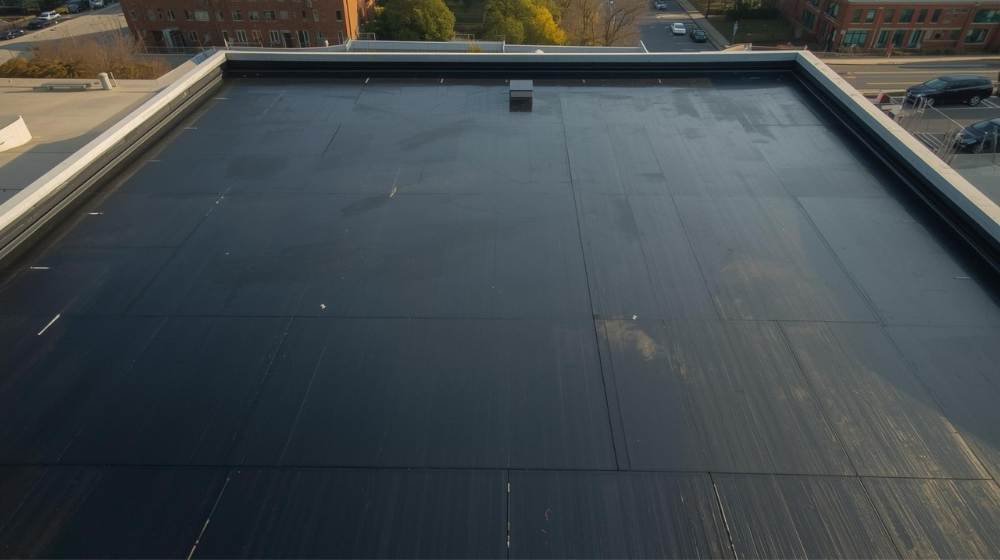
Comparison of Rubber Roofing with Other Roofing Materials.
When choosing the best roofing material, it’s important to compare rubber roofing with other options to find what works best for your needs. Let’s break down rubber roofing and compare it with asphalt shingles, metal roofing, tile roofing, PVC, and TPO based on five key factors: cost, durability, maintenance, energy efficiency, and installation.
| Factor | Rubber Roofing (EPDM) | Asphalt Shingles | Metal Roofing | Tile Roofing | PVC Roofing | TPO Roofing |
| Cost | $4-$7 per sq. ft. | $3-$5 per sq. ft. | $6-$12 per sq. ft. | $8-$15 per sq. ft. | $6-$10 per sq. ft. | $5-$9 per sq. ft. |
| Durability | 30-50 years | 15-20 years | 40-70 years | 50-100 years | 30-50 years | 25-40 years |
| Maintenance | Low | Medium | Low | Medium | Low | Low |
| Energy Efficiency | 30% savings | 10-20% savings | 20-30% savings | 10-15% savings | 20-25% savings | 30-40% savings |
| Installation | Easy, professional needed | Easy, DIY-friendly | Professional only | Professional only | Professional only | Professional only |
Consider the long-term benefits of rubber roofing.
Rubber roofing is an excellent investment for the long term. Here are the key long-term benefits you can enjoy with rubber roofing:
- Longevity: Can last 30 to 50 years or more with proper care.
- Energy Savings: Rubber roofing can provide up to 30% energy savings because of its reflective properties.
- Low Maintenance: Requires minimal maintenance, which saves you on repair costs.
- Weather Resistance: Prevent extreme weather and reduce the chance of costly damage.
- Environmentally Friendly: Made from recycled materials and is recyclable at the end of its lifespan.
What are the different types of rubber roofing?
There are three main types of rubber roofing used for different purposes. These include EPDM (Ethylene Propylene Diene Monomer), TPO (Thermoplastic Olefin), and PVC (Polyvinyl Chloride). Each type offers different benefits depending on your needs. Let’s explore their features.
| Feature | EPDM | TPO | PVC |
| Material | Synthetic rubber | Plastic (Olefin) | Plastic (Vinyl) |
| Color Options | Black, White, Gray | White, Light colors | White, Light colors |
| Durability | 30-50 years | 20-30 years | 30-50 years |
| Energy Efficiency | Reflective, moderate | Highly reflective | Highly reflective |
| Cost | $4-$7 per sq. ft. | $5-$9 per sq. ft. | $6-$10 per sq. ft. |
| Installation | Easy, professional | Easy, professional | Professional only |
Which Type of Rubber Roofing Is Best for Brooklyn?
For Brooklyn’s climate, EPDM and TPO are the best options. EPDM is durable enough to handle cold winters and hot summers, which makes it perfect for Brooklyn’s unpredictable weather. TPO is excellent for energy savings because of its highly reflective nature. These features keep your building cooler during the warmer months. Both options offer long-lasting performance and are well-suited for flat roofs.
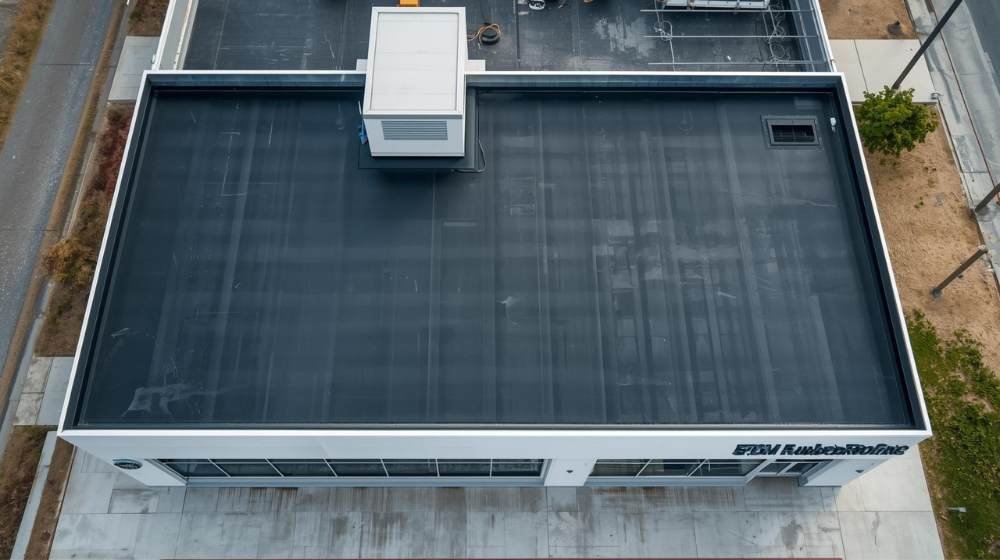
Where to Choose a Professional Roofing Contractor?
Are you looking for an expert roofing contractor in Brooklyn, NYC? SR General Construction has you covered! Our business is located at 8807 Avenue B, Brooklyn, NY 11236, United States, in the Canarsie area.
We proudly serve all areas of Brooklyn with high-quality, durable roofing solutions. From new installations to repairs and maintenance, we provide the best service at affordable prices. Contact us and experience why we’re Brooklyn’s roofing experts!
FAQ
1. What is rubber roofing made of?
Rubber roofing is typically made of EPDM (Ethylene Propylene Diene Monomer), a synthetic rubber compound. It is designed for flat or low-slope roofs and is highly durable, waterproof, and resistant to extreme weather.
2. How long does a rubber roof last?
A rubber roof can last 30 to 50 years with proper care. The material is known for its long lifespan, especially when installed and maintained correctly.
3. Is rubber roofing environmentally friendly?
Yes, rubber roofing is an eco-friendly option. It is often made from recycled materials and can be recycled at the end of its life, reducing waste.
4. How much does rubber roofing cost?
The installation cost of rubber roofing ranges from $4 to $7 per square foot. It depends on the material and labor involved. While it’s an affordable option, it may have higher installation costs than asphalt shingles.
5. What is the best type of rubber roofing?
The best type of rubber roofing depends on your needs. EPDM is the most common and affordable option, while TPO offers higher reflectivity for energy savings. PVC is excellent for roofs exposed to chemicals.
6. Is rubber roofing good for flat roofs?
Yes, rubber roofing is an excellent choice for flat roofs. Its waterproof nature and seamless installation make it ideal for flat or low-slope roofs, where water drainage can be an issue.
